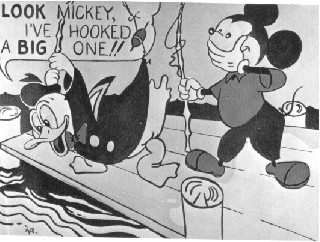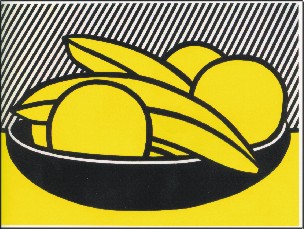Página Principal > Cultura > Roy Lichtenstein
|
ROY LICHTENSTEIN
|
El Ricón de Jordi
|
Roy Lichtenstein has been the most famous Pop Artist of this century. His Paintings are mostly Pop Art. But, if we look at his work, we can see different currents. In this project I am going to concentrate on his work don in the 70s. I have chosen this period of his work because most of the sculptures we saw at the IVAM (Instituto Valenciano de Arte Moderno) are from this decade. The thing that most impressed me about Roy Lichtenstein was his sculptures, and I would like to concentrate on them in this project.I also have to add that I enjoyed going to Lichtenstein exhibition, because Pop Art is the only style I do not find boring.

He was born in New York in the 27 of October of 1923. He studied at Ohio Art University and received degree in 1949. At the beginning of his career in 1951, his main interest was American 19-century history. He painted cowboys and Indians modern paintings. In 1957 he tried abstract Expressionism. In the 60s Lichtenstein announced a new current: POP ART. This was the first commercial art, and as so, at first it had to fight the criticisms. His first pop art work was based in comics. His interest in comic strip started with a Mickey Mouse painting in 1960 for his children.

Look Mickey. 1961. Oil on canvas, 48 x 69.
As we can see in his first paintings, they were really commercial. One example is the comic in the chewing gum cover, where he enlarged and interpreted it. In the 1960s he also painted some comics like "Good Morning" or "Darling". The 60s subjects were very varied, he did: comics, Still Lifes, Landscapes, Works of Art, Explosions, Brushstrokes, Stretcher Frames, Modern Paintings and serial paintings. Also an example of another style we saw in the IVAM was Art Deco sculptures. Although they were not very interesting, this proves us that he dominated every single current.

Study for Long Modern Sculpture. 1969. Brass, 12 x 96 x 1.25.
The thing I like about Lichtenstein was that he was continuously experimenting, and on the long list of see, we can see very different themes, but all of them were really done in his incredible original style. His paintings were done by hand, but using the same techniques of a printer: with dots and bright color. This is what makes Lichtenstein unique. He soon became famous. Hi exhibitions at the Tate Gallery (London) in 1968 and in Guggenheim Museum (New York) in 1969 had very good critics. In the 70s, Lichtenstein worked in Southampton (Long Island). He painted many original works like: Mirrors, Entablatures, Still Lifes, Abstractions and Brush strokes. These paintings have given Lichtenstein the quality of "provocateur". As we can see in many of his comic Brush Strokes, he is laughing of abstract artists.
Finally, in his last years he has been painting ancient Chinese comic art as the shown below.

Chinese landscape.
STILL LIFES
Many of the paintings we saw in the IVAM were still lifes. Lichtenstein started exploring still lifes in the 60s. He started with specific single objects. For example, he did: Roto Broil, 1961; Tire, 1962; and Jewels, 1963. They were very, very simplified. But this led in the 70s to more simplified complex paintings. The 70s still lifes began very simplified paintings. An example of this still lifes is: Bananas and Grapefruit, and as shown below, we can see a single kitchen object, with a very simple background, and very bright color. Only yellow and black are used.

Bananas & Grape Fruit #1. 1972, Oil and Magna on canvas, 20 x 20.
His scales are much larger than life. He starts experimenting with trays, crystal bowls, candy jars, and many objects in which he was interested. In still lifes work there is a tendency to add more objects, as we can see in Cape Cod Still Life I and II; or in Still Life with Goldfish (shown below), in this particular painting we can see a golf ball and a plant in the background, and some lemons and goldfish in front. In this painting we can see how he has drawn the crystal bowl in a very complicated way.

Still Life with Goldfish. 1972, Oil and Magna on canvas, 52 x 42.
As we can see in his paintings, Lichtenstein avoids all textures. But you have standard indicators, which show you what each figure represents, and this makes it seem very nice. You can clearly distinguish an apple from a lemon, even though they are the same color, because one is round and flat, and the lemon is ovoid. This is quite shocking for me, because Lichtenstein is nearly in the limit of abstract.
SCULPTURES
We also saw sculptures in the IVAM. In the 60s Lichtenstein experimented with Long Modern Sculpture, which we now as Art Deco (we saw some Art Deco at the beginning of the exposition), but it was to complex, and he finally gave up. In the 1970s, he started experimenting transforming Still Lifes paintings into sculpture. Some examples are: Still Life with Goldfish (above), Oysters, Fish in a bowl, Book, Glass and Lemon, Before a Mirror. He started of with a wooden maquette painted in magna. The sculptures are not flat, and you had to look through the right perspective. This was one of the things that impressed me more. The colors were exactly the same as the painting. A very curious thing is that you could not identify the gaps in the sculpture. Certainly, what I liked most about Lichtenstein, were his sculptures. We saw some curious explosions, which impressed me a lot. The explosions were done in bronze or steel, and he used very bright colors. Some examples we saw in the exposition: Cup and Saucer II or Lamp on Table (both below), really impressed me. If you look at Cup and Saucer II from far away, you will think the cup is in 3-D, but it is in 2-D, because a circular plate sustains it. Another thing that impresses me of this painting was the vapor, and the nice-looking way he has done it. Also, I like a lot, how simplified it is, and the combination of bright colors. I also liked Lamp on table. It looks very simple, but the way it has been done is very complex. If you look at it you can see a long table, but when you go to one side, you can see that it is less than a meter wide. Another curious thing about this sculpture is how he has represented light. A thing I like about Lichtenstein is how he represents things that you do not see, like vapor or light. Another curious sculpture we saw in the exhibition were the 3-D houses.

CONCLUSION
I really liked the exhibition. At first I did not have much interest, because I was told that there were very little comics. But after I saw the exhibition, the things in which I was more interested were sculpture. In this project I have also done Still Life, because it was the basement of all the sculptures. I found very interesting the strange way he used perspective, because only in certain places you got the right perspective. I also find amusing, all the work he has done, it is like mass production, and sometimes he had various versions of one title, like Cup and Saucer I and II. Another thing I liked was the whole lot of currents he dominated, from the serious Art Deco, to the sarcastic Brushstrokes. Also, a very especial and original thing about Lichtenstein was the way he painted his work, he was like human printer, which used dots and bright colors. As concluding sentence, I would like to say that Lichtenstein has been one of the most original and innovative artist of this century.
Bibliography:
Lichtenstein 1970-1980. Jack Cowart. Hudson Hills Press.
Pop Art. Tilman Osterwold.Taschen.










